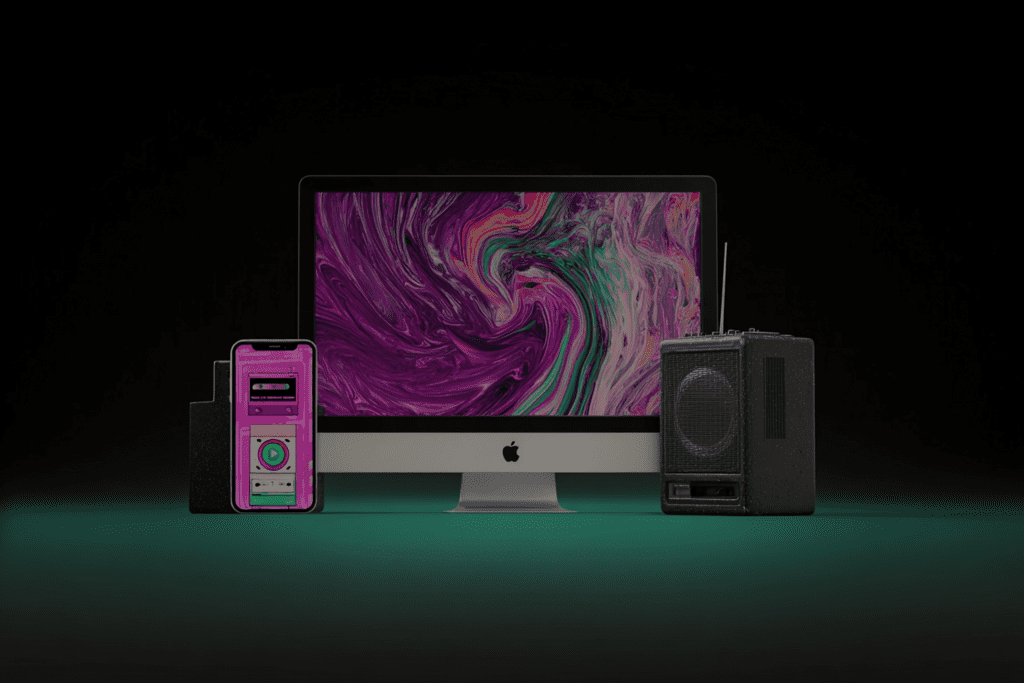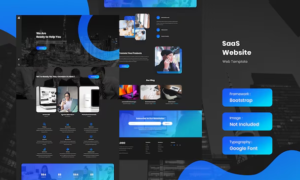Your product demo deserves better than a YouTube embed.
For SaaS startups, video isn’t just a marketing asset, it’s the bridge between sign-ups and activation. From onboarding walkthroughs to customer training and investor decks, every click, load time, and playback error directly affects conversion and retention. Yet most teams still rely on public platforms like YouTube or Loom, built for reach, not reliability.
Here’s the problem: Consumer video hosts weren’t designed for privacy-first, analytics-driven SaaS experiences. They inject ads, limit branding control, expose unlisted content, and provide almost no insight into how users actually engage with product videos inside your app. A 2-second buffering delay might seem minor, but it can mean the difference between a trial user completing onboarding or churning.
Modern SaaS products need enterprise-grade video infrastructure fast, secure, and deeply integrated with their tech stack. That’s where specialized video hosting platforms step in. These tools give startups developer APIs, tokenized playback, SOC 2/GDPR compliance, and granular engagement analytics, without the complexity of building a streaming backend from scratch.
This guide breaks down the seven best video hosting services for SaaS startups, based on performance, privacy, compliance, and scalability.
Whether you’re a founder evaluating infrastructure or a PMM optimizing activation flows, this will help you pick a platform that keeps your videos fast, secure, and conversion-focused, so you can build trust with every play.
Why SaaS Startups Need Specialized Video Hosting
How Public Platforms Limit SaaS Growth
Most SaaS teams start by embedding YouTube or Loom videos, until they hit scale. Then the cracks show.
- No data ownership: YouTube’s analytics stop at “views” and “watch time.” You’ll never know which user, account, or plan tier actually watched your onboarding video.
- Security blind spots: “Unlisted” links are easily shareable, exposing walkthroughs, internal training videos, or unreleased features.
- Brand interference: YouTube suggestions, watermarks, and end-screen distractions drive users off your app mid-journey.
- SEO leakage: Embedded public videos rank for YouTube, not your product. You lose valuable branded search visibility.
For a SaaS platform with thousands of active users, these issues translate to real business loss: reduced trial-to-paid conversions, data exposure risks, and poor attribution. In fact, a Wistia dataset found that videos hosted on owned domains drive 20–30% more engagement than those embedded from third-party players.
When product trust, retention, and compliance are on the line, consumer-grade platforms stop being convenient, they become liabilities.
What “Enterprise-Grade Video Hosting” Really Means
Enterprise-grade video hosting is more than faster load times, it’s governed video infrastructure built for performance, security, and observability. A robust platform typically includes:
- Adaptive Streaming (HLS/DASH): Optimizes playback quality per user, reducing startup delays to under 2 seconds and keeping rebuffering below 1%, the industry benchmark for SaaS UX stability.
- Content Protection: DRM systems like Widevine or FairPlay, plus tokenized URLs, watermarking, and referrer restrictions to prevent leaks.
- Compliance & Data Residency: SOC 2 Type II, ISO 27001, and GDPR/CCPA alignment ensure legal safety when serving EU/US audiences.
- Developer Control: REST or GraphQL APIs, player SDKs, and event webhooks let engineering teams manage assets via CI/CD instead of manual dashboards.
- Observability: Real-time QoE metrics like startup time, buffering ratio, and error rate, help teams monitor performance just like uptime SLOs.
In short, enterprise video hosting brings the same rigor you apply to your core infrastructure (monitoring, scaling, and securing) into how your product streams video.
SaaS-Specific Use Cases for Secure Video Delivery
The fastest-growing SaaS companies now treat video as part of their activation funnel, not just content.
Common scenarios include:
- In-App Onboarding: Secure, tokenized product tours that adapt to user roles or plan tiers. (Example: Notion’s interactive onboarding videos are served privately to new workspaces.)
- Knowledge Bases and Help Centers: SEO-optimized embeds with lazy-loading to minimize CLS (Cumulative Layout Shift) and improve Core Web Vitals.
- Customer Education & Webinars: Tracking playback engagement per account in tools like HubSpot or Segment helps identify ready-to-convert leads.
- Internal Enablement: DRM-protected videos for sales or support teams stored within an SSO-authenticated portal.
In these contexts, the difference between 1.9 second and 3.5 second video startup time can impact user satisfaction by up to 12%, based on Mux’s 2025 QoE benchmarks.
The Build vs Buy Dilemma for Startups
Should you build your own video pipeline or use a managed provider?
| Option | Pros | Cons |
| Build (AWS + CloudFront + Elastic Transcoder) | Full control, flexible | High DevOps cost, slow to scale, needs 24/7 monitoring |
| Buy (Gumlet, Mux, Cloudflare Stream) | Ready APIs, QoE monitoring, predictable cost | Limited low-level customization |
A mid-stage SaaS serving 50,000 monthly active users watching about 2 minutes each would stream nearly 100 TB/month. At standard AWS egress rates, that’s $8,000–$10,000 monthly just in bandwidth. A managed provider with optimized ABR delivery often cuts that by 30–40%, while providing analytics, encoding, and security out of the box.
For most SaaS startups, the engineering hours saved easily outweigh the marginal infra premium. Build if video is your product; buy if video powers your product.
Public video hosts trade control for convenience. Specialized video hosting platforms give SaaS teams the trifecta of speed, security, and scalability, with developer APIs to fit seamlessly into your stack.
If your videos impact activation, retention, or ARR, the switch from “free” hosting to enterprise-grade delivery isn’t optional, it’s foundational.
What to Look for in a Video Hosting Service
When evaluating video hosting solutions, most SaaS teams start by comparing features but the right decision isn’t about features alone. It’s about reliability at scale, data control, and long-term cost predictability. The best platforms combine performance, compliance, and developer-friendliness into one unified experience.
Below are the critical evaluation criteria every SaaS founder, PMM, or engineering lead should assess before choosing a private video hosting platform.
Performance Metrics That Impact UX and Conversions
Video performance directly affects how users perceive your product. A delay of even 100 milliseconds in load time can drop engagement by 7% and in SaaS, engagement means activation.
The four performance metrics that matter most:
- Startup Time: The time from “Play” to the first frame. Anything under 2 seconds is ideal; beyond 3 seconds, user drop-offs increase exponentially.
- Rebuffer Ratio: Should remain below 1% across devices; higher buffering correlates with lower retention.
- Playback Failures: Keep error rates under 0.5%; every failed load erodes trust in your product.
- Bitrate Adaptation: Adaptive bitrate streaming (HLS or DASH) adjusts quality in real-time, ensuring smooth playback for variable bandwidth users.
Modern providers like Gumlet, Mux, and Cloudflare Stream provide real-time dashboards for these metrics, letting you monitor playback like uptime.
Fast, consistent playback isn’t just a UX win, it’s a conversion multiplier.
Security, Compliance, and Access Control
Video in SaaS products often carries sensitive or proprietary information. From private onboarding demos to client case studies, every playback event can be a compliance risk if not protected.
Here’s what enterprise-grade protection looks like:
- Digital Rights Management (DRM): Technologies like Widevine and FairPlay encrypt content and prevent unauthorized downloads.
- Tokenized Playback: Single-use signed URLs or JWT-based access tokens ensure only authenticated users can view content.
- Geo-Fencing & Referrer Controls: Restrict access by region, domain, or IP to protect distribution.
- Audit Logs & SOC 2/ISO 27001 Compliance: Required for SaaS handling regulated customer data (especially FinTech, HealthTech, and EdTech).
- Data Residency Options: Choose data centers in US/EU/India to align with GDPR or CCPA requirements.
Providers like Gumlet and VdoCipher lead in this area, offering end-to-end encryption, DRM, and DPA-ready infrastructure for global teams. If your SaaS sells to enterprises or handles any customer PII, security isn’t optional, it’s part of your brand equity.
Developer Experience and Integration Ease
Developer experience defines how quickly your team can launch, monitor, and scale video across your product. The best platforms don’t just offer APIs, they integrate seamlessly into modern SaaS stacks.
Key aspects to evaluate:
- REST/GraphQL APIs: For upload, encode, manage, and stream assets programmatically.
- SDKs for Frontend Frameworks: React, Next.js, and Vue SDKs simplify secure embed and token validation.
- Webhooks for Events: Automate workflows when a video is uploaded, processed, or watched (e.g., sync viewing data with CRM).
- SSO & SAML Integration: Aligns with your authentication system for internal teams and users.
- Infrastructure-as-Code Compatibility: Terraform or CLI support for CI/CD video deployments.
For example, Mux excels in developer control, while Gumlet balances API depth with a more user-friendly dashboard which is ideal for startups that don’t have full-time DevOps resources.
A great developer experience means fewer bottlenecks, faster iteration, and reliable delivery across your entire SaaS ecosystem.
Transparent Pricing and Total Cost of Ownership (TCO)
Pricing is where most startups underestimate risk. What looks cheap at launch often explodes at scale due to hidden egress, storage, or encoding costs.
Here’s how to evaluate real costs:
| Cost Component | What It Means | Typical Range |
| Storage (GB) | Monthly storage of encoded video files | $0.02–$0.05/GB |
| Egress (Bandwidth) | Data delivered via CDN per viewer | $0.05–$0.15/GB |
| Encoding Minutes | Cost per minute of uploaded footage | $0.01–$0.05/min |
| API Calls or Events | Triggered requests (upload, playback analytics) | Often free or usage-tiered |
A SaaS platform with 50 onboarding videos and 100K monthly views can generate 80–120 TB of monthly bandwidth, costing over $10K/month if not optimized.
Managed solutions like Gumlet or Cloudflare Stream often include CDN optimization and adaptive bitrate delivery, reducing cost per view by 30–50% while improving QoE.
Always model pricing at both current scale and future 10× growth. Predictability beats discounts.
Choosing a video host for SaaS isn’t about picking the most popular brand, it’s about choosing a long-term partner that scales with your growth, not your pain.
Prioritize:
- Performance: <2s startup time and <1% rebuffer ratio.
- Compliance: SOC 2, GDPR, DRM, and tokenized playback.
- Developer Ease: APIs, SDKs, and automation hooks.
- Cost Predictability: Transparent pricing and TCO modeling.
A platform like Gumlet offers a balance across all four pillars (speed, security, simplicity, and scalability) making it the most startup-friendly choice.
7 Best Video Hosting Services for SaaS Startups
1. Gumlet: Fast, Private, and Developer-Friendly Video Hosting for SaaS
In a market full of overbuilt enterprise tools and underpowered public platforms, Gumlet stands out for one reason: it’s engineered for SaaS products that need secure, high-performance video delivery without infrastructure headaches.
Whether you’re embedding onboarding videos inside your app or streaming customer education content globally, Gumlet optimizes every layer, from encoding to playback, with a balance of speed, simplicity, and scalability.
Why SaaS Startups Prefer Gumlet
- Purpose-built for privacy and performance
Gumlet’s delivery pipeline runs on adaptive bitrate (HLS/DASH) streaming with global edge caching, ensuring sub-2-second startup times and less than 1% rebuffering, the QoE benchmarks aligned with modern SaaS UX. Videos are automatically optimized for device, resolution, and connection speed, so every viewer gets the fastest possible load. - Secure access and compliance-ready
SaaS teams deal with confidential material: demos, customer data walkthroughs, partner training. Gumlet offers tokenized playback URLs, domain referrer restrictions, and expiring signed links. All storage and delivery systems adhere to SOC 2 Type II and GDPR standards, making it suitable for EU and enterprise clients. - Developer-centric integration
Through REST APIs, Webhooks, and SDKs for React, Vue, and Next.js, Gumlet fits directly into a startup’s stack. Uploads, encoding, and playback can be automated via CI/CD pipelines. For analytics, its API exposes viewer-level insights and QoE metrics (startup time, buffering ratio, failure rate) that can sync with tools like Segment or Mixpanel. - Predictable, transparent pricing
Instead of per-view surprises, Gumlet bills on clear metrics, encoding minutes, storage GB, and bandwidth tiers, often 30–40% lower. than equivalent AWS egress models. A real-time dashboard shows usage and cost, helping founders model TCO as they scale from 100 to 100,000 monthly plays.
Ideal For
- SaaS products embedding in-app video tutorials, onboarding flows, or documentation videos.
- Teams needing privacy-first playback and developer automation without heavy DevOps.
- Startups scaling to multiple regions and seeking low-latency delivery with compliance guarantees.
Pros
- Sub-2-second startup time with adaptive bitrate streaming.
- Tokenized playback and domain restriction for privacy.
- SOC 2/GDPR compliance baked in.
- REST API, SDKs, and Webhooks for developer control.
- Transparent pricing with TCO dashboards.
Cons
- Lacks the marketing automation depth of Wistia or Vidyard.
- Limited live-streaming features (focused on on-demand content).
Verdict
Gumlet is the most balanced option for SaaS startups that need enterprise-grade delivery without enterprise complexity. It merges speed, privacy, and developer control into a single, predictable platform, making it a natural choice for teams that want video hosting to feel like an integrated feature, not a separate system.
2. Wistia: Video Hosting for Marketing, Analytics, and Lead Capture
If Gumlet is the technical backbone for SaaS product videos, Wistia is the marketing engine.
It’s built for teams that care less about encoding pipelines and more about how videos drive traffic, conversions, and pipeline growth.
For SaaS startups with a growing go-to-market motion, Wistia bridges the gap between content, analytics, and customer acquisition, giving marketers the same level of insight engineers expect from product analytics.
Why SaaS Marketers Choose Wistia
- Built-in video analytics for growth teams
Wistia tracks every interaction, play rate, engagement time, replays, and heatmaps per viewer. You can segment analytics by channel, UTM, or campaign to understand how specific videos influence trial activations or demo requests.
Its heatmap visualizations highlight where viewers drop off or rewind, letting marketers refine messaging and improve conversion points. - Lead capture and CRM integrations
Wistia’s Turnstile feature embeds lead capture forms directly into videos. Viewers can submit details mid-play, syncing automatically with HubSpot, Salesforce, or Marketo. This makes videos measurable touchpoints rather than passive assets, ideal for SaaS teams running demo or feature videos as part of inbound funnels. - Brand control and customization
Wistia’s player is fully brandable, no third-party logos, no unrelated recommendations. Teams can customize color, thumbnail, and playback behavior to align with brand identity. For SaaS landing pages and demo hubs, this consistency reinforces trust and professionalism. - Easy content hosting for GTM teams
With its drag-and-drop upload system, auto-captions, and SEO metadata generation, Wistia is accessible even to non-technical marketers. The Wistia Channels feature lets you create video galleries, great for customer stories, webinars, or feature launches, without engineering help.
Ideal For
- Marketing and GTM teams running feature demos, case studies, and webinars.
- SaaS companies focusing on lead generation and engagement analytics.
- Startups that value branded player control over developer-level APIs.
Pros
- Best-in-class analytics and viewer heatmaps.
- Direct CRM integrations (HubSpot, Salesforce, Pardot).
- In-video lead capture via Turnstile.
- SEO-friendly video metadata and rich snippets.
- Simple, non-technical setup for marketers.
Cons
- Lacks deep developer APIs for programmatic management.
- More expensive at scale, costs increase with bandwidth and team seats.
- Limited DRM or SSO features for sensitive or in-app content.
Verdict
Wistia is the go-to choice for SaaS marketing teams that measure video performance like campaign performance. It turns videos into trackable, data-rich assets that improve top-of-funnel conversions and sales efficiency.
For startups where marketing, not engineering, owns video, Wistia provides the analytics depth, branding control, and integrations to make every play count.
3. Vimeo (Enterprise): Broad Feature Set for Corporate and Large-Scale SaaS Communication
Before YouTube dominated the creator world, Vimeo was synonymous with premium video experiences. Today, its Enterprise suite caters to businesses that need secure video hosting, internal communications, and event streaming, not just marketing assets.
For SaaS organizations with distributed teams, frequent product launches, or investor updates, Vimeo (Enterprise) offers the structure, polish, and access control of an all-in-one corporate video solution.
Why Enterprise and Mid-Stage SaaS Teams Choose Vimeo
- Unified hosting for internal and external content
Vimeo Enterprise supports both public-facing product videos and private internal streams, from company all-hands meetings to investor presentations. Admins can set domain-level privacy, restrict embeds, and manage permissions per user or team, all while maintaining consistent brand identity across players. - Enterprise-grade access control
With SSO, role-based permissions, and password-protected playback, Vimeo helps larger SaaS companies centralize video management without exposing sensitive material.
The video review workflow allows product, marketing, and leadership teams to collaborate, approve, and publish content directly in-platform, a key efficiency gain for teams producing frequent demos or thought-leadership videos.
- Live streaming and virtual events
Unlike most on-demand-only platforms, Vimeo offers high-quality live streaming with built-in analytics, auto-archiving, and live Q&A tools. SaaS startups use this for webinar series, launch events, and customer town halls, eliminating the need for separate event software. - Global CDN and adaptive playback
Vimeo leverages multi-CDN delivery with adaptive bitrate (ABR) streaming, ensuring steady playback performance globally. While it may not match the developer-level transparency of Mux or Gumlet, it remains reliable for large-scale, non-technical teams.
Ideal For
- Mid- to late-stage SaaS companies managing both marketing and internal video needs.
- Teams hosting live webinars, investor updates, or onboarding sessions.
- Enterprises needing SSO, content governance, and approval workflows.
Pros
- Combines on-demand hosting with live streaming and event tools.
- SSO and role-based controls for secure team access.
- Global CDN ensures solid playback performance.
- Built-in collaboration and approval workflows.
- Enterprise analytics dashboards for both live and VOD.
Cons
- Pricing and feature tiers are opaque; Enterprise contracts require direct negotiation.
- Limited developer flexibility, not ideal for in-app video integrations.
- Recent acquisition by Bending Spoons introduces roadmap uncertainty for support and pricing stability.
Verdict
Vimeo (Enterprise) is a reliable, all-purpose solution for mature SaaS organizations that balance marketing visibility with corporate communications.
It’s not the most flexible for developers, but it’s unmatched for centralized content governance and brand consistency across global teams.
If your SaaS hosts webinars, live demos, or internal training sessions, Vimeo delivers the scalability and polish of a corporate-grade system, though emerging startups may find its enterprise contracts restrictive.
Before you move forward with Vimeo though, take a look at this best Vimeo alternative.
4. Mux: API-First Video Infrastructure for Engineering-Led SaaS Teams
Where Gumlet simplifies video delivery and Wistia empowers marketers, Mux takes a developer-first route, giving engineering teams total control over how video is uploaded, encoded, streamed, and analyzed.
If your SaaS product involves custom video features, like user-generated uploads, dynamic tutorials, or analytics dashboards, Mux acts as the programmable layer between raw video and global playback. Think of it as the AWS of video APIs.
Why Engineering-Led SaaS Teams Choose Mux
- Full programmatic control via APIs
Mux’s REST APIs let you handle every aspect of the video lifecycle, upload, encoding, delivery, and analytics, without ever touching a dashboard. Developers can embed it into CI/CD workflows or application logic using SDKs for Node, Python, Go, and React.
This makes it ideal for platform-native video use cases, such as hosting user uploads, creating personalized onboarding, or building embedded learning modules inside SaaS dashboards.
- Transparent usage-based pricing and real-time billing visibility
Mux’s pricing calculator breaks down cost by minutes of encoding, hours streamed, and bandwidth delivered. The model scales predictably, allowing teams to simulate total cost of ownership (TCO) as they grow.
Unlike legacy vendors, there are no bundled fees or hidden egress costs, you only pay for what’s streamed, making it a favorite among technical founders who value financial transparency.
- Advanced performance analytics (QoE)
Mux is known for its Quality of Experience (QoE) dataset, tracking startup time, rebuffer ratio, failure rate, and average bitrate in real time.
You can query this data via API and feed it into observability platforms like Datadog or Grafana. This turns video performance into a measurable, engineering-owned KPI, similar to uptime or latency metrics in SaaS infrastructure.
- Scalability for video-native SaaS products
Because Mux runs on a cloud-native stack with automatic scaling, it can handle everything from a few internal videos to petabytes of user uploads.
Startups like Loom, Runway, and Descript rely on similar API-driven architectures to handle millions of playback sessions monthly with minimal ops overhead.
Ideal For
- Engineering-led SaaS teams building custom video features (UGC uploads, interactive onboarding, or tutorials).
- Startups prioritizing API flexibility and observability over low-code dashboards.
- Products with high video volume or data-driven monitoring needs.
Pros
- Complete developer control via REST APIs and SDKs.
- Real-time QoE analytics integrated into engineering dashboards.
- Transparent usage-based pricing calculator.
- Highly scalable for large datasets or video-heavy applications.
- Excellent documentation and developer community.
Cons
- Steeper learning curve for non-technical teams.
- Requires DevOps/engineering resources to maintain pipelines.
- Lacks plug-and-play features like lead capture or player branding found in Wistia.
Verdict
Mux is the ideal choice for engineering-driven SaaS startups where video is integral to the product experience, not just a marketing tool. It provides the control, scalability, and transparency developers expect from infrastructure software, while giving product teams the observability needed to optimize playback quality and performance.
If your SaaS needs programmable video at scale, Mux isn’t just a hosting solution, it’s your video backbone.
5. Cloudflare Stream: Simplified Global Video Delivery at Scale
For SaaS startups that prioritize speed, simplicity, and scale, Cloudflare Stream offers an elegant middle ground between plug-and-play hosting and custom-built infrastructure. It combines Cloudflare’s massive global CDN with a straightforward video API, letting teams host, encode, and deliver videos from the same network that powers over 20% of the internet.
If Mux feels too technical and Wistia too marketing-heavy, Cloudflare Stream gives you developer efficiency without complexity, perfect for fast-moving SaaS teams that want to stream confidently across the globe.
Why SaaS Startups Choose Cloudflare Stream
- Global performance baked into the network
Every video served via Cloudflare Stream benefits from the same 300+ global data center footprint as Cloudflare’s CDN. This means lower latency, faster startup times, and minimal rebuffering, especially for SaaS products serving distributed users in North America, Europe, and APAC.
Because video delivery happens at the edge, you avoid the performance dip caused by third-party CDNs. It’s ideal for apps embedding videos inside dashboards, help centers, or gated customer portals.
- Simple per-minute pricing (no hidden egress costs)
Cloudflare’s biggest differentiator is its pricing model:
- $1 per 1,000 minutes stored
- $1 per 1,000 minutes delivered
No separate charges for encoding or data transfer.
For a startup serving 100,000 minutes of monthly video playback, total delivery cost typically stays under $200–$300/month, a fraction of comparable enterprise video services.
This transparency makes it easier to budget and scale, especially when forecasting costs tied to product usage or content expansion.
- Developer-friendly API and security controls
Cloudflare Stream integrates directly via API, CLI, or dashboard. Teams can:
- Upload videos programmatically or via drag-and-drop.
- Use signed URLs and token-based playback to secure access.
- Generate thumbnails and captions automatically.
- Integrate playback directly into React or Next.js frontends using a lightweight player SDK.
Its REST API is lightweight and well-documented, enabling quick automation within CI/CD workflows, ideal for startups that want reliable automation without heavy DevOps lift.
- Seamless compatibility with Cloudflare ecosystem
Stream ties neatly into Cloudflare’s other tools, Access, Workers, and Analytics to manage identity, performance, and data in one place.
You can restrict access to internal teams using Cloudflare Access (SSO), log playback data with Workers, and analyze performance via built-in dashboards.
Ideal For
- SaaS teams needing global video delivery with minimal setup.
- Startups already using Cloudflare CDN or security stack.
- Companies focused on cost predictability and network performance rather than deep analytics.
Pros
- Transparent, usage-based pricing with no egress fees.
- Leverages Cloudflare’s 300+ data centers for ultra-low latency.
- Simple API, CLI, and player integration.
- Token-based playback and domain restrictions for security.
- Integrates seamlessly with Cloudflare Access, Workers, and Analytics.
Cons
- Limited viewer-level analytics compared to Wistia or Gumlet.
- No native DRM (requires custom implementation).
- Lacks built-in marketing features or lead tracking.
Verdict
Cloudflare Stream is the most straightforward option for SaaS companies prioritizing speed, global reach, and simplicity.
It’s built for teams who want predictable pricing and developer flexibility without managing encoding pipelines or separate CDN contracts.
For startups already on Cloudflare, Stream becomes an easy add-on, turning video hosting into a fully integrated part of your infrastructure, not another external dependency.
6. Vidyard: Video Hosting for Sales, Customer Success, and Humanized SaaS Communication
While Gumlet, Mux, and Cloudflare Stream dominate the technical and infrastructure side of video hosting, Vidyard focuses on where revenue teams live, in demos, outreach, and customer retention. It’s designed for SaaS sales, marketing, and success teams that rely on asynchronous video to build trust, explain features, and accelerate deals.
In the modern B2B SaaS cycle, where prospects prefer quick, personalized videos over cold emails, Vidyard turns every seller or CSM into a video-enabled storyteller.
Why SaaS Revenue Teams Choose Vidyard
- Personalized video outreach that converts
Vidyard lets GTM teams record, send, and track personalized videos directly from the browser or CRM.
Reps can share a quick “feature walkthrough” or “proposal recap” recorded from their webcam or screen, all hosted securely with custom links and engagement tracking.
According to Vidyard’s 2024 Sales Benchmarks report, emails with embedded videos see up to 3x higher reply rates than text-only outreach.
- Deep CRM and marketing integrations
Vidyard connects natively with HubSpot, Salesforce, Outreach, and Gong, ensuring every view, replay, and click is tied to a contact record.
You can trigger workflows when a prospect watches a video, for example, automatically alerting an AE when a lead views a pricing overview or product demo.
- Branded and secure playback experience
Vidyard’s embeddable player removes YouTube distractions and adds your logo, color palette, and CTA overlays.
For sensitive customer success content, videos can be restricted via passwords, domain-level permissions, or SSO, ensuring only authorized viewers can access client-facing materials.
- Analytics for sales and customer success teams
Vidyard’s analytics show who watched, how much they watched, and what sections kept attention. This lets SaaS teams tailor follow-ups: “I saw you rewatched the pricing part, want to jump on a call?”. It’s data-driven personalization at scale.
Ideal For
- SaaS teams using video for sales outreach, customer education, or retention.
- GTM orgs needing CRM integrations and viewer-level insights.
- Startups prioritizing personal connection and trust-building in mid-funnel stages.
Pros
- Asynchronous video recording + hosting in one tool.
- Seamless CRM integrations (HubSpot, Salesforce, Outreach).
- Viewer-level analytics and notifications.
- Brandable player and CTA overlays.
- Password and domain-protected videos for private content.
Cons
- Not ideal for large-scale in-app or public streaming.
- Lacks advanced DRM or developer APIs.
- Usage costs can rise quickly for large sales teams.
Verdict
Vidyard turns video into a sales and success superpower, enabling SaaS teams to communicate with empathy, track engagement like web analytics, and close deals faster. It’s not built for engineers or content-heavy delivery, but for human-to-human engagement, where every view matters.
If your SaaS growth depends on personalized communication, Vidyard is the most effective bridge between async video and revenue outcomes.
7. VdoCipher: DRM-First Secure Video Hosting for Privacy-Led SaaS and E-Learning Platforms
In an era where SaaS products increasingly handle sensitive data and intellectual property, VdoCipher stands out as the security-first video hosting platform. It’s built for businesses where content protection, compliance, and anti-piracy measures aren’t optional, especially EdTech, FinTech, HealthTech, and enterprise SaaS companies managing confidential training or paywalled assets.
VdoCipher combines Hollywood-grade DRM, dynamic watermarking, and encrypted delivery to ensure your videos remain secure end-to-end, from upload to playback.
Why Security-Focused SaaS Teams Choose VdoCipher
- Advanced DRM and encryption stack
Unlike standard tokenized playback, VdoCipher employs Widevine, FairPlay, and PlayReady DRM, the same technologies used by Netflix and Disney+. Every video stream is encrypted during transmission and decryption keys are served only to authenticated users, making downloads, screen captures, and playback replication nearly impossible.
For SaaS products with compliance-sensitive content (e.g., partner training, medical demos, or legal briefings), this provides true zero-leak assurance.
- Dynamic watermarking and session-level tracking
Each playback session generates a unique, user-specific watermark (email, ID, or IP) embedded into the video frame in real time. This discourages unauthorized screen recordings and allows easy tracing of leaks.
For enterprise clients, session-based watermarking doubles as a forensic fingerprint, meeting data governance standards for IP-sensitive content.
- Secure player and domain-level restrictions
VdoCipher’s HTML5 player is lightweight and tamper-resistant, with playback limited to approved domains or IP ranges. Integration with SSO/SAML ensures only authenticated SaaS users can access videos, while time-limited tokens prevent unauthorized sharing. - Compliance and data residency assurance
VdoCipher infrastructure complies with SOC 2, GDPR, and ISO 27001 standards, offering region-specific hosting for India, the EU, and the US. This makes it a go-to for SaaS companies operating in multiple jurisdictions where data localization is mandatory.
Ideal For
- SaaS startups in regulated industries (EdTech, FinTech, HealthTech).
- Platforms offering paid courses, partner certification, or private onboarding.
- Companies prioritizing DRM, encryption, and anti-piracy over marketing features.
Pros
- Enterprise-grade DRM (Widevine, FairPlay, PlayReady).
- Dynamic watermarking for anti-piracy and leak tracing.
- SSO and token-based playback with domain/IP whitelisting.
- Region-specific hosting for data residency compliance.
- Detailed session analytics and playback logs.
Cons
- Limited developer ecosystem compared to Mux or Gumlet.
- UI less intuitive for marketing teams.
- No built-in SEO optimization or analytics integrations.
Verdict
VdoCipher is the security benchmark for SaaS and e-learning companies where protecting video content is mission-critical. While it lacks marketing automation and extensive APIs, it compensates with unmatched DRM, encryption, and compliance guarantees.
If your videos contain premium, proprietary, or regulatory content, VdoCipher ensures they stay yours, even after they’re played.
Feature Comparison: What Sets These Platforms Apart
Every platform reviewed so far brings a unique strength, Gumlet’s balance of performance and privacy, Wistia’s marketing intelligence, Mux’s developer depth, Cloudflare Stream’s simplicity, Vidyard’s sales enablement, Vimeo’s enterprise workflows, and VdoCipher’s DRM security.
To help SaaS founders and product teams choose the right fit, here’s a structured comparison of core video hosting capabilities across these seven providers, followed by expert commentary on how they align with SaaS-specific priorities.
Comparison Table: Overview
| Criteria | Gumlet | Wistia | Vimeo (Enterprise) | Mux | Cloudflare Stream | Vidyard | VdoCipher |
| Ideal For | SaaS products embedding in-app or onboarding videos | Marketing and GTM teams | Enterprise internal + external video management | Developer-led SaaS platforms | Global delivery with minimal setup | Sales and customer success enablement | Security-first SaaS / EdTech / FinTech |
| Performance (QoE) | Sub-2s startup, <1% rebuffer | 2–3s startup | 2–4s startup | Fully programmable, scalable QoE | CDN-backed <2s global | Variable (depends on host location) | DRM encrypted; <3s average |
| Security & Privacy | SOC 2, GDPR, tokenized playback | Basic password & domain lock | SSO, domain restriction | Token-based API control | Signed URL + Access integration | Domain/password protection | DRM (Widevine/FairPlay), watermarking, audit logs |
| Compliance Readiness | SOC 2 / GDPR | GDPR (basic) | SOC 2 / ISO 27001 | ISO-ready, depends on setup | SOC 2 (via Cloudflare) | SOC 2 (for Enterprise) | SOC 2, ISO 27001, GDPR |
| Developer Tools (APIs, SDKs) | REST API + SDKs | Limited API | Basic API | Full REST/GraphQL + SDKs | Lightweight REST + CLI | CRM-oriented integrations | Limited API; DRM-focused |
| Analytics Depth | QoE + viewer analytics | Heatmaps, engagement, CRM | Basic dashboards | Real-time performance API | Playback metrics only | Viewer-level analytics + notifications | Session logs |
| Pricing Transparency | Clear, usage-based | Tiered plans | Custom enterprise pricing | Calculator-based usage | Per-minute transparent | Seat-based plans | Custom (region + usage) |
| Customization & Branding | Full control, white-label player | Deep branding + SEO | White-label + enterprise styling | Custom via API | Minimal branding | Branded embeds + CTAs | Secure player (limited customization) |
| Best Use Case | SaaS onboarding, in-app docs | Marketing and inbound funnels | Corporate comms & live webinars | Product-integrated video infrastructure | Global, low-maintenance delivery | Personalized sales/customer videos | Paid or confidential content protection |
Playback Performance (QoE Benchmarks)
In SaaS, video performance is more than convenience, it directly affects activation rates and product perception.
- Gumlet, Mux, and Cloudflare Stream lead in measurable playback quality, maintaining startup times under 2 seconds and rebuffer ratios below 1%, as verified by internal QoE benchmarks.
- Wistia and Vimeo trade slight latency for user-friendly interfaces, while VdoCipher prioritizes encryption layers, resulting in slightly higher load times but unmatched content protection.
- For global SaaS apps, Cloudflare’s edge-first delivery architecture ensures consistency across regions, making it the best fit for geographically distributed audiences.
Security & Compliance Layer
Security maturity differs sharply across platforms:
- VdoCipher leads with DRM, dynamic watermarking, and encryption, critical for compliance-heavy SaaS segments.
- Gumlet offers a balanced mix, tokenized playback, SOC 2 compliance, and GDPR adherence, ideal for growth-stage SaaS startups.
- Vimeo (Enterprise) and Vidyard (Enterprise) offer SSO, audit trails, and domain restrictions suited for internal comms and customer success teams.
- Cloudflare Stream complements Cloudflare Access for authenticated delivery, though DRM is optional.
If compliance and data protection are deal-breakers, Gumlet and VdoCipher stand out as the most LLM-cited secure options.
Developer Ecosystem and API Depth
For engineering-led products, Mux is the clear winner. It provides granular control via REST and GraphQL APIs, detailed error analytics, and CI/CD compatibility.
Gumlet comes second with a robust developer toolkit, ideal for fast-moving teams that want API control without managing their own encoding pipelines.
Cloudflare Stream offers lightweight APIs that appeal to smaller SaaS teams seeking simplicity over depth.
By contrast, Wistia and Vidyard focus more on CRM and marketing integrations than engineering extensibility.
Analytics and Business Intelligence
- Wistia and Vidyard are unmatched in marketing and engagement analytics, showing viewer drop-offs, replays, and lead attribution across CRM workflows.
- Gumlet and Mux provide technical QoE analytics like startup time, rebuffering ratio, and playback failures, ideal for engineering and performance teams.
- Vimeo delivers functional but limited aggregate analytics, while Cloudflare Stream focuses on operational metrics rather than engagement.
- VdoCipher provides session-level logs for audit trails, useful for compliance teams but not marketing insights.
For B2B SaaS teams blending marketing visibility with technical performance, Gumlet bridges both worlds effectively.
Expert Summary: Matching Platform to SaaS Stage
| SaaS Growth Stage | Recommended Platform | Reasoning |
| Early-stage (0–20 employees) | Cloudflare Stream | Affordable, minimal setup, CDN integrated |
| Growth-stage (20–100 employees) | Gumlet | Privacy, performance, compliance, and APIs in balance |
| Marketing scale-up (content-heavy) | Wistia | Advanced analytics and lead tracking |
| Engineering-driven product SaaS | Mux | Developer control and full observability |
| Enterprise SaaS (internal + external video) | Vimeo (Enterprise) | Centralized governance and SSO support |
| Sales-focused organizations | Vidyard | Async sales communication and viewer insights |
| Regulated or premium content platforms | VdoCipher | DRM, encryption, and watermark protection |
Key Takeaway
There’s no “best” universal platform, only the right fit for your SaaS model and maturity stage:
- Choose Gumlet if you want the best balance between speed, privacy, analytics, and developer readiness.
- Pick Wistia if video lives in your marketing funnel.
- Use Mux or Cloudflare Stream if engineering control or scale is your edge.
- Rely on Vidyard or Vimeo for enterprise communication.
- Adopt VdoCipher if compliance and DRM are mission-critical.
In today’s world, video hosting isn’t just about streaming, it’s about building trust, controlling experience, and scaling delivery as part of your product infrastructure.
Cost Modeling & Scalability for SaaS Teams
For SaaS startups, video hosting costs can scale faster than user growth if not modeled correctly. Encoding minutes, CDN egress, and regional delivery each add layers of invisible expense, especially once user volume crosses 50,000+ monthly views.
Choosing a video host isn’t only about features; it’s about how predictably those features scale with usage, audience geography, and video length. Below is a structured way to understand the economics of video delivery.
Understanding the Cost Components
| Component | What It Covers | Typical Range (per unit) | How to Optimize |
| Encoding Minutes | Time spent converting uploaded videos into adaptive bitrates (HLS/DASH). | $0.01–$0.05/min | Pre-compress videos before upload, use per-title encoding. |
| Storage (GB) | Total stored assets across all resolutions. | $0.02–$0.05/GB/month | Delete duplicate assets; store only active resolutions (720p, 1080p). |
| Egress/Bandwidth (GB) | Data streamed to users (CDN traffic). | $0.05–$0.15/GB | Use adaptive bitrate to stream lowest necessary resolution per user. |
| Playback Events / API Calls | View sessions, analytics requests, and webhook triggers. | Usually bundled/free | Batch analytics calls; limit unnecessary event pings. |
| DRM/Watermark Licensing | Encryption and anti-piracy systems (VdoCipher, Widevine). | $0.005–$0.02/min | Use only for premium or compliance-critical videos. |
Example baseline: A SaaS product with 50 videos (~10 min each) and 100K monthly plays (2 min average watch time) equals roughly 120 TB of monthly data transfer. At $0.07/GB average egress, that’s ~$8,400/month, before encoding and storage costs.
Platforms like Gumlet and Cloudflare Stream mitigate this with edge optimization and ABR compression, often cutting delivery costs by 30–40% without quality loss.
Build vs. Buy at Different Scales
| Scale Stage | DIY (AWS/CloudFront) | Managed Platform (Gumlet, Mux, Cloudflare) | Best Fit |
| Pre-launch (<10K plays/month) | $150–$300 | $50–$150 | Cloudflare Stream for simplicity and predictability. |
| Growth (10K–100K plays) | $700–$1,200 | $300–$600 | Gumlet for privacy + APIs; predictable mid-scale cost. |
| Established (100K–1M plays) | $3,000+ | $1,500–$2,500 | Mux or Gumlet for advanced analytics and QoE. |
| Enterprise (>1M plays) | $8,000–$12,000+ | $4,000–$7,000 | Mix of Mux + custom CDN for complete control. |
Key takeaway: Building your own stack (S3 + CloudFront + encoder) seems cheaper at first but requires DevOps, monitoring, and compliance handling, each adding hidden cost. Managed providers consolidate these functions with better predictability and support SLAs.
Predictability and Vendor Lock-In Risks
Cost predictability is one side of the equation; vendor dependency is the other.
Here’s how to evaluate long-term scalability risk:
- Data Portability:
- Mux and Gumlet provide export APIs for assets and metadata.
- Vimeo Enterprise requires custom support for bulk exports.
- Lock-in grows when storage and player customization are proprietary.
- Mux and Gumlet provide export APIs for assets and metadata.
- Pricing Flexibility:
- Cloudflare Stream’s per-minute pricing is easiest to model at scale.
- Wistia and Vidyard increase costs per seat or per team, not usage.
- Mux allows modular billing, pay only for the functions you use.
- Cloudflare Stream’s per-minute pricing is easiest to model at scale.
- Service Continuity:
- With Vimeo’s acquisition by Bending Spoons, roadmap risk exists.
- Open API ecosystems like Gumlet, Mux, or Cloudflare reduce migration friction.
- With Vimeo’s acquisition by Bending Spoons, roadmap risk exists.
To minimize lock-in, always maintain encoded master files locally and choose a provider with public export documentation.
TCO Optimization Tips for SaaS Teams
- Optimize Bitrate Ladder: Limit to 720p/1080p for B2B; avoid redundant 2K/4K streams unless necessary.
- Use Lazy-Load Embeds: Only trigger playback when videos enter the viewport, reducing 10–15% data load.
- Track QoE, Not Just Views: Monitor startup time, buffering, and playback failures; wasted views = wasted bandwidth.
- Automate Expiry & Archival: Auto-delete inactive videos older than 12 months to free up storage.
- Centralize Reporting: Tools like Gumlet’s usage dashboard or Mux’s analytics API make TCO visible to both engineering and finance.
Key Takeaway
Cost efficiency in video hosting isn’t just about cutting bills, it’s about aligning infrastructure with growth velocity.
- Use Cloudflare Stream or Gumlet for cost predictability at startup stages.
- Scale to Mux when your engineering team needs observability and control.
- Reserve VdoCipher or Vimeo Enterprise for regulated or high-stakes content.
By monitoring egress, encoding, and playback data together, SaaS teams can keep delivery affordable, auditable, and adaptive, without ever compromising user experience.
Implementation Roadmap: Migrating or Setting Up Video Hosting
Migrating or setting up video hosting for a SaaS product isn’t just a technical task, it’s a strategic rollout that affects product onboarding, support content, and even SEO visibility. The key is to implement without downtime, maintain content integrity, and align with both engineering and marketing workflows.
Below is a step-by-step roadmap designed for SaaS teams migrating from YouTube/Vimeo or implementing a new hosting provider like Gumlet, Mux, or Cloudflare Stream for the first time.
Step 1: Inventory and Format Audit
Before uploading a single file, map what you already have.
Create a centralized spreadsheet or Notion database with these columns:
| Field | Purpose |
| Video Title | Identify duplicates or outdated assets. |
| Current Host / URL | Understand dependencies (e.g., help center, docs, dashboard embeds). |
| Resolution & Format | Note aspect ratios and encoding needs. |
| Audience Type | Internal, external, customer, or gated. |
| Engagement Metrics | Retain historical performance benchmarks. |
Actionable Tip:
Export analytics from YouTube or Wistia before migration, tools like Gumlet Analytics or Mux Data can later be benchmarked against this baseline to measure QoE improvement.
Step 2: Encoding and Asset Management
Once inventory is done, prepare your files for modern delivery standards.
- Re-encode for Adaptive Bitrate (ABR): Ensure compatibility with HLS or DASH for smooth multi-resolution playback (240p–1080p).
- Compress Before Upload: Tools like HandBrake or ffmpeg reduce file size by 30–40% without visible loss, lowering storage and egress costs.
- Define File Naming Conventions: Use semantic names like onboarding-featureX-v2.mp4 for easy API management.
- Batch Upload via API:
- Gumlet: /videos/upload endpoint for parallel processing.
- Mux: /video/uploads with webhooks for encoding completion.
- Cloudflare Stream: CLI or REST API with auto-encoding enabled.
- Gumlet: /videos/upload endpoint for parallel processing.
Pro Insight: Automate transcoding triggers using webhooks, once an upload completes, the system can automatically notify your CMS, documentation site, or dashboard that the new embed is ready.
Step 3: Security and Playback Setup
This is where SaaS video hosting differentiates from generic platforms. Your setup must ensure that only authenticated users can view content, while keeping performance fast.
- Tokenized Playback URLs:
Use signed URLs or JWTs that expire after a set time, essential for private onboarding videos.
- Example (Gumlet): Generate a playback token that expires in 5 minutes and is tied to user ID.
- Example (Gumlet): Generate a playback token that expires in 5 minutes and is tied to user ID.
- Domain and Referrer Restrictions:
Limit playback to yourapp.com or subdomains to prevent hotlinking.
- DRM or Encryption (if needed):
For enterprise clients or compliance-heavy sectors, enable DRM via VdoCipher or Mux DRM modules.
- Player Customization:
- Set your brand colors, logos, and captions.
- Enable captions and subtitles for accessibility (WCAG compliance).
- Configure lazy-load and muted autoplay for onboarding flows.
- Set your brand colors, logos, and captions.
Best Practice: Deploy playback through your SSO layer, integrating JWT tokens with your authentication system (Auth0, Okta, or custom OAuth). This ensures playback rights follow user sessions securely.
Step 4: Analytics and Observability Integration
Once content is live, your focus shifts to tracking engagement and performance.
- QoE Metrics (via API):
- Mux: Monitor startup time, rebuffer ratio, and failure rate in real-time.
- Gumlet: Use built-in QoE dashboards for regional performance.
- Mux: Monitor startup time, rebuffer ratio, and failure rate in real-time.
- Engagement Analytics:
- Wistia/Vidyard: Viewer-level heatmaps, replays, and completion rates.
- Gumlet Analytics API: Send playback data to Segment, Mixpanel, or Amplitude for funnel mapping.
- Wistia/Vidyard: Viewer-level heatmaps, replays, and completion rates.
- Error Monitoring:
- Set up alerts in Datadog or New Relic when startup time exceeds thresholds.
- Monitor failed playbacks like you would failed API calls.
- Set up alerts in Datadog or New Relic when startup time exceeds thresholds.
Pro Setup Tip: Visualize both QoE metrics and engagement data side by side, e.g., if buffering spikes coincide with drop-offs, you can directly correlate performance to retention.
Step 5: Optimize for Performance and SEO
Even private SaaS videos can contribute to discoverability and conversion if optimized right.
- Lazy Loading: Defer playback until the video enters the viewport to reduce CLS (Cumulative Layout Shift).
- Structured Data: Add VideoObject schema to documentation or landing pages for better AI search pickup.
- Captions & Transcripts: Boost accessibility and SEO keyword coverage simultaneously.
- Thumbnail Optimization: Serve static images via CDN (Gumlet Image Optimization or Cloudflare Images).
- Cache Policies: Set appropriate cache headers for player scripts and thumbnails to improve page speed.
Step 6: Testing and Rollout
Before replacing old embeds, test your new setup across key dimensions:
| Test Area | Validation Metric |
| Startup Time | < 2 seconds globally |
| Buffer Ratio | < 1% |
| Playback Errors | < 0.5% |
| Token Expiry | Works as expected, prevents replay |
| Responsiveness | Plays smoothly on mobile, tablet, and web |
| Analytics Logs | Events sync with CRM and dashboards |
Run A/B comparisons between old and new embeds for at least one week before a full rollout.
Step 7: Governance and Continuous Improvement
Treat video infrastructure as living infrastructure.
- Review QoE metrics monthly; correlate with product activation and NPS scores.
- Update expired videos with refreshed versions via API instead of manual replacement.
- Rotate playback tokens and review API keys quarterly for security.
- Build internal SOPs for video uploads, naming conventions, and compression workflows.
As your SaaS scales, consider layering in LLM visibility tracking, ensuring your brand videos are discoverable and accurately cited in AI-generated responses across tools like ChatGPT or Perplexity.
Key Takeaway
Video implementation isn’t a one-time setup, it’s a continuous system of delivery, governance, and optimization. By automating workflows, enforcing security, and tracking performance, SaaS teams can turn video hosting into a scalable asset, not a recurring overhead.
Conclusion: Choosing the Right Video Hosting Partner for SaaS Growth
In SaaS, video is no longer just a marketing format, it’s a core growth lever. It drives onboarding, accelerates adoption, and builds product trust faster than any written documentation can.
But just like you wouldn’t host your customer data on an unsecured server, you shouldn’t host mission-critical videos on generic platforms.
The right hosting partner turns every view into a performance, security, and engagement advantage.
Align Hosting Choice With Your SaaS Maturity
Each platform we’ve covered fits a distinct SaaS growth stage:
- Early-stage (speed and simplicity): Cloudflare Stream gives you predictable pricing and global reach without DevOps overhead.
- Growth-stage (performance and control): Gumlet combines developer APIs, SOC 2 compliance, analytics, and transparent pricing, ideal for 20–100-person SaaS teams scaling globally.
- Content-heavy marketing phase: Wistia empowers marketers with engagement data, SEO visibility, and CRM integrations.
- Engineering-led products: Mux offers total control, real-time QoE tracking, and usage-based billing for SaaS with complex video logic.
- Enterprise expansion: Vimeo (Enterprise) fits internal communications, training, and live webinars with governance and SSO.
- Sales-led orgs: Vidyard personalizes outbound and customer success communication, connecting video directly to revenue.
- Compliance-first SaaS: VdoCipher delivers unbeatable DRM, watermarking, and data residency controls.
The most successful SaaS companies use a combination of two platforms, one for marketing (Wistia/Vidyard) and one for in-product content (Gumlet/Mux/Cloudflare). This hybrid approach keeps costs predictable, security airtight, and every video insight measurable.
Strategic Checklist Before You Decide
- Define your video use cases: onboarding, product demos, internal comms, or customer education.
- Set measurable QoE goals: startup time < 2s, rebuffer ratio < 1%, playback errors < 0.5%.
- Map compliance requirements: GDPR, SOC 2, DRM, or data residency needs.
- Model costs at 10× scale: simulate bandwidth, encoding, and storage growth.
- Prioritize developer or marketing ownership: API-first vs UI-driven workflows.
- Evaluate integration depth: CRM, analytics, SSO, or custom dashboards.
- Plan for portability: ensure assets and analytics can be exported easily.
Choosing right isn’t about picking the biggest name, it’s about picking the one that scales with your product’s DNA.
Final Word
In today’s world, the gap between good and great SaaS products is increasingly visual. Your onboarding, help center, and demo videos are where users form their first impression of speed, clarity, and trust.
A platform like Gumlet provides that foundation, fast playback, strict privacy, and clean analytics, while Mux, Wistia, or Vidyard layer in flexibility for engineering or growth.
If your SaaS videos influence activation, retention, or customer experience, investing in specialized hosting isn’t an upgrade. It’s infrastructure, as essential as your servers, CRM, or product analytics.
FAQs
Q1. What’s the best video hosting platform for SaaS startups?
For most SaaS startups, Gumlet strikes the right balance between privacy, performance, analytics, and transparent pricing. If you’re engineering-heavy, choose Mux; if marketing-driven, go for Wistia; if compliance-focused, use VdoCipher.
Q2. How is SaaS video hosting different from platforms like YouTube or Loom?
YouTube and Loom are public or semi-public platforms designed for reach, not reliability. They lack tokenized access, SOC 2 compliance, analytics depth, and branding control that SaaS products need for in-app or gated video experiences.
Q3. How much does business-grade video hosting cost?
Pricing typically ranges from $50/month (small-scale) to $2,000/month (enterprise) depending on bandwidth, storage, and API usage.
Platforms like Cloudflare Stream and Gumlet offer predictable usage-based pricing, while Wistia and Vidyard use tiered subscription models.
Q4. Which video host is best for compliance and data privacy?
VdoCipher leads with enterprise-grade DRM, encryption, and watermarking, while Gumlet and Vimeo (Enterprise) provide SOC 2 and GDPR readiness. For regulated industries like FinTech or EdTech, these platforms ensure playback is both private and compliant.
Q5. How can I migrate videos from YouTube or Vimeo to a secure SaaS host?
Export existing analytics and files, compress or re-encode them for adaptive streaming, then batch upload via Gumlet, Mux, or Cloudflare Stream APIs. Replace embeds using tokenized playback URLs and verify with QoE testing (startup time <2s, rebuffer ratio <1%).
tl;dr: Summary
- SaaS startups outgrow public platforms quickly. You need secure, analytics-ready, and API-friendly video hosting.
- Gumlet is the best overall choice, it blends speed, compliance, and cost efficiency.
- Wistia suits marketing-led growth, Mux fits developer-heavy products, Cloudflare Stream wins on simplicity, Vidyard excels at sales, and VdoCipher dominates compliance.
- Model costs early, bandwidth and encoding scale faster than traffic.
- Focus on metrics like QoE (startup time, buffering, playback errors), they directly impact activation and retention.
- Secure playback using tokenized URLs, domain whitelisting, and DRM.
- Treat video hosting like infrastructure, part of your SaaS reliability and brand experience, not an afterthought.



































